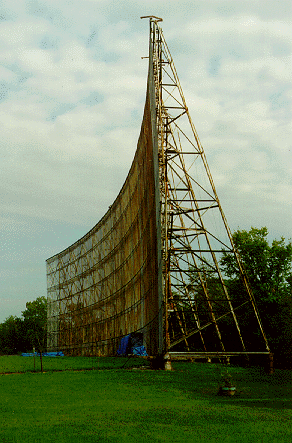 The photo at the left shows the paraboloidal
(curved) reflector. Find the hot spot on the aerial photo for the flat
reflector to see the wire mesh surface (the same wire mesh was used on
both the flat reflector and the paraboloidal reflector).
The photo at the left shows the paraboloidal
(curved) reflector. Find the hot spot on the aerial photo for the flat
reflector to see the wire mesh surface (the same wire mesh was used on
both the flat reflector and the paraboloidal reflector).
The word "mirror" is sometimes used in place of the word "reflector". In many optical telescopes, one or more mirrors reflect the light to a focal point. A concave type of curved mirror will focus the light to a point or to a focal region. A flat mirror will reflect the light to a different direction without focussing. Similarly, radio waves (energy) can be focussed by a concave type of curved metallic structure (reflector or mirror), while a flat metallic structure (reflector or mirror) will send the radio waves (energy) to a different direction without focussing.
The word "parabola" is sometimes incorrectly used for the word "paraboloid". In 2 dimensions (on a flat or plane surface), a parabola is a type of geometric figure in which the distance from a point called the "focus" to any point on the parabola (call it point P) plus the shortest distance from point P to a straight line perpendicular to the axis (called the directrix) is the same no matter where point P is located (as long as it is on the parabola).
If a 2-dimensional parabola is rotated on its axis, we have the 3- dimensional geometrical figure called a paraboloid. An important property of a paraboloidal reflector is that a wave of energy from a very distant source gets focussed at one point. [Note. Sometimes the term "parabolic reflector" or just "parabola" is used when talking about the paraboloidal reflector. Even though this usage is incorrect, almost everyone understands what is meant.]
The Big Ear paraboloidal reflector was 360 feet (110 meters) wide (along the east-west line) by 70 feet (21 meters) high. It was curved so that radio waves that hit it were focussed 420 feet (128 meters) away at the feed horns (look for a hot spot on the photo for the feed horns). The surfaces of both the flat and paraboloidal reflectors were made of wire mesh, which reflected radio waves very well. [Note that light waves, having much smaller wavelengths than the radio waves, pass through the mesh easily.]
Most of our observations were made over a band of frequencies near 1411 - 1419 MHz (megahertz = millions of cycles per second) or else in the vicinity of the neutral hydrogen line (1420.4045 MHz; note Doppler shift affects the actual frequency of observation). The corresponding wavelength is about 21.1 centimeters (0.211 meters, or about 8.3 inches). For radio waves of such wavelength, almost all of the radio waves hitting either the flat or the paraboloidal reflectors were reflected; very little incoming radio energy got through the openings in the wire mesh.